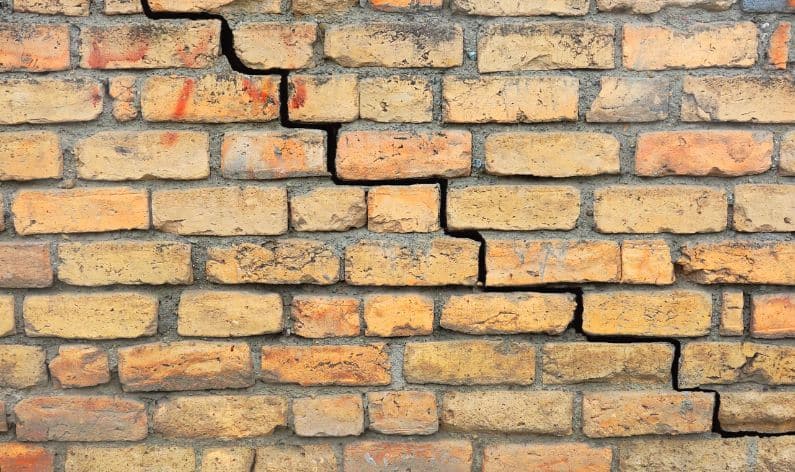If your home’s foundation walls are bowing, you must find a way to stop and repair the damage before it worsens. The bowing of foundation walls is one of the most common signs of structural damage in a home.
Whether you suspect structural damage or are just looking for ways to prevent it from occurring, there are a few steps to identify if your foundation walls are bowing. Let’s look at them in detail.
Common Signs of Foundation Wall Bowing
Are you worried that your foundation walls may be bowing? If so, you’re not alone. Foundation wall bowing is a common problem for homeowners and commercial property owners. It can cause serious structural damage to the foundation of your home or building, and you should address it as soon as possible.
Visible Cracking & Bulging in Walls
The most visible sign that your foundation walls are bowing is cracking. If you notice any cracks or bulges in your interior or exterior walls, it’s important to contact a professional right away. These indicate a serious problem with your foundation that you need to address as soon as possible. Look for horizontal, vertical, or diagonal cracks in the walls, and take pictures for documentation.
Uneven Floors & Sagging Ceilings
Other signs of foundation wall bowing include uneven floors and sagging ceilings. If you notice any areas where the flooring appears uneven or if you spot any dips in the roof, these could be signs of foundation wall bowing.
Once again, it’s important to contact a professional immediately if you notice these signs so that they can assess the severity of the issue. These professionals will help you determine what steps are necessary to address it. Tell them the location of the signs you noticed and provide them with photos if possible.
Sticking Doors & Windows
Finally, sticking doors and windows can indicate a foundation wall-bowing problem. Doors and windows should be easy to close and open, but if they stick in areas they never did before, that issue can indicate foundation shifting.
The door or window may have a bowed frame, leading it to not fit between the surrounding walls. If you experience sticking doors and windows, you should contact an interior foundation repair specialist to evaluate your home and address the bowing problem.
How To Prevent Foundation Wall Bowing
Foundation wall bowing can be a major problem for homeowners. Bowing walls can cause cracks, water leakage, and other structural problems requiring costly repairs. Fortunately, there are steps you can take to help prevent foundation wall bowing from happening in the first place.
Identifying Potential Problems
The first step in preventing foundation wall bowing is identifying any potential issues before they become serious problems. The most common signs of a bowing wall include cracks in the foundation walls, water leakage, and doors and windows that are difficult to use due to misalignment.
If you notice these signs, it is important to contact a professional immediately so that they can assess the situation and recommend a course of action.
Preventative Measures
Once you identify potential problems with your foundation walls, you can take several steps to prevent them from worsening. One of the most important things you can do is ensure that your gutters are always clean and debris-free. Clogged gutters can cause rainwater to collect around the foundation, leading to water seepage and eventual wall bowing.
Additionally, you should ensure that your landscaping has a good grade away from your home. This step ensures surface runoff does not end up near your foundation walls. Lastly, keeping an eye on trees near your home is essential, as their roots may grow too close and put pressure on your foundation walls, causing them to bow.
Repairing Foundation Wall Bowing
Repairing the damage caused by foundation wall bowing is often complicated and expensive. In the most severe cases, replacing the entire foundation wall may be necessary. However, for less serious cases, you can take a few steps to repair the damage.
Identify the Source of the Problem
The first step in repairing foundation wall bowing is to identify the source of the problem and address it directly. This step could involve improving drainage around your home or installing waterproofing systems such as sump pumps and French drains. Once you take care of this issue, you can start looking into ways to repair any damage from the bowing.
Install Reinforcements
One option is installing steel reinforcement bars on top of the bowed walls to prevent further damage from soil pressure or movement. You may also want to consider installing tiebacks; these steel rods attach from outside your home into the structure, helping support and hold your walls in place.
Consider Replacing the Foundation Walls
Lastly, suppose you’re dealing with severe foundation wall bowing that you cannot repair with steel reinforcements or tiebacks. In that case, you may need to consider complete replacement—which involves tearing down the existing structure and replacing it with a new one more suited to your needs. While this might seem extreme, it could save you money in the long run by helping you avoid costly repairs later on.
If you suspect your home’s foundation walls are bowing, you must take action quickly before it worsens. Properly identifying and addressing bowing foundations can help ensure your home remains structurally sound.
By following these simple steps and contacting a professional if necessary, you can rest assured that your house will be safe and secure for years to come! The last thing you want is for your foundation walls to bow and require costly repairs. Taking preventive measures now can help you avoid this scenario in the future.
The Crack Guys can help with foundation repair and wall bowing. With our experienced team of highly trained professionals, you can quickly address this issue. Contact us today to learn more about our services and how we can help you tackle your bowing walls and ensure the structural integrity of your home. We look forward to hearing from you!




